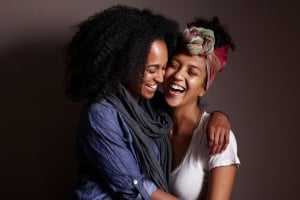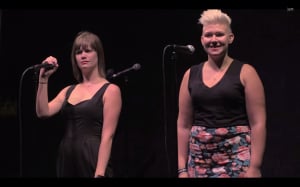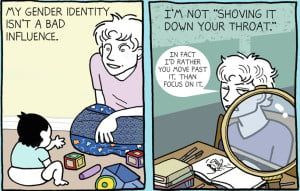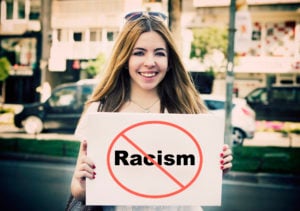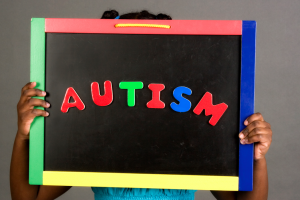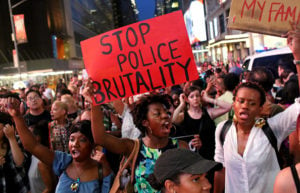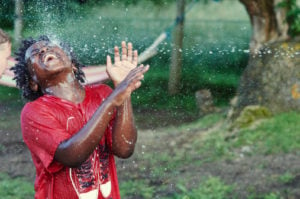Originally published on Change From Within, and cross-posted here with their permission.

A child raises its hand, seeming to protect theirselves.
What do you consider normal?
I work in the field of primary prevention of sexual violence. In doing so, I work with many diverse populations. My focus, though, is with youth of Color, ages 12-18. This is one of the first things I ask them.
I say, “If you see your neighbor reading his newspaper on his porch in his underwear, would that be weird for you?”
They giggle and cringe thinking about the perceived awkwardness.
Then I ask, “What if you saw it every day for years, he always does the same thing. Would it be weird then?” They shake their heads, many times even responding that it would be “normal,” and I explain that this is called “normalization.”
But when we get into discussions of what normalized violence they see or feel, the conversation is divergent from how normalization is many times approached.
The conversation doesn’t usually, as I first expected, focus on the media and the messages that the youth were constantly being bombarded with but instead often focuses on real violence they were experiencing.
This was jarring for me.
Having the privilege of never experiencing domestic and sexual violence, I was confident in dealing in the abstracts of the media and language we use, only to be confronted with a male student, 13, who was almost in tears after a session where we discussed sexual harassment. He came up to me after the program.
“You’re saying it’s wrong to holla at women on the street?”
I sat with him, discussing consent and how the person being called at might feel. He nodded, understanding and agreed with me that being called at could make someone scarred or feel violated.
Then he looked at me and asked why his father told him to do it whenever they were in the car.
It took me a while to answer, but I responded by telling him that he could make choices about whether to participate in the action or not, to which he responded that he didn’t want to, and would not do it anymore.
I felt that this was the best outcome I could hope for, but it brought to my attention the fact that as anti-violence presenters, many times when we identify violence that others many not see, we challenge social norms.
But with that we also have to realize that these norms are a fundamental basis for many youth.
Pushing Back Against Normalization
Generational violence is a huge normalizing factor, and challenging a youth’s parents, or at least their teachings, can be very difficult for some kids.
Do I think we need to back off? No.
Do I think we need to dumb it down? No.
Do we need to acknowledge that violence is a foundational part of the lives of many young people? Absolutely.
Many of my students have seen more in their middle of high school lives than I have in 24 years. These students understand violence more than I do.
My academic background, ability to quote theorists and call upon citable data may make me feel like I understand violence. But when a student asks me why they feel weird when their boyfriend grabs them or that they cry at night because of bullying at school, I am overwhelmed with my own hubris.
People of Color experience sexual violence at disproportionate rates in this country, as do youth, making the kids I see more likely to experience sexual violence than most.
Even though I know that, sometimes it is easy to walk into a room of youth and assume that I am the expert. But after almost a year of doing this job, I realize I am not.
I am a translator; I will help change the language, but the youth understand violence.
Where the disconnect lies is that because of our culture, the violence is not always seen as something that’s wrong.
Slap Ass Fridays
Case in point: There is a weekly holiday among many middles schoolers in New Mexico: Slap Ass Fridays.
As the rather self-explanatory name implies, Slap Ass Fridays involves students chasing each other around and slapping each other on the rear. It is a game that does not appear to be gender segregated, and in schools where it occurs, it seems almost universal.
When I teach middle school programs, our classes are gender segregated so I am only speaking with the young men. When first asked about it, many of the students discuss how fun it is, how the girls must like it because they try and get them back and how they don’t want to stop playing it.
From my point of view, I am seeing non-consensual contact on a wide scale, normalized to the point that students defend the practice. I ask them, “Do you think the girls enjoy it as well?” and I am met with a resounding “Yes!”
However, my coworker presents to the young women, and her experience is significantly different than mine.
Her students speak of hiding in teachers classrooms during lunch, sitting down as much as possible all day, or just letting it happen, because if they run away, they only “get it worse.”
When told how their classmates view the game, the boys are always taken aback, stunned that playful violence was causing any real harm.
This is the disconnect I am speaking of.
Many of the students view the game as violent — as one of my students said snarkily to me, “Well of course it’s violence, it has the word slap in it.”
What they do not understand is why that violence is wrong.
They are growing up in communities that are violent, in a country that glorifies violence, and in a world where violent role models abound.
In trying to change knowledge attitudes and beliefs of my students, I have realized that not only are they the experts on violence, but their confusion as to why it is wrong personifies much of our struggle as an anti-violence community.
We live in a world in which dominance and victory through violence is delivered as normal. While we work to change those views, it is our responsibility to help build nonviolent community alternatives as well.
Providing Non-Violent Alternatives
We must not only identify parts of ourselves and our culture that are violent, but replace them with compassion and strength through togetherness and community.
Simply destabilizing rape culture does not ensure the outcome is going to be positive.
Any cracks in the foundation that we have created must be filled with equally strong resolve to heal and build compassion.
Youth, especially high-risk youth, need strength and safety, and sadly violence can deliver those things much of the time through the feeling of power when one is dominant.
Delivering that strength, that safety, without force requires us not only to analyze what we want from society, but also what we can learn from our communal experiences with violence.
The youth I work with understand violence, but they also understand growth. They want to live in a safe community, and they want the strength to stand up for what they believe in, that is what we must deliver.
We cannot treat them as children, but as future leaders and soldiers for peace and justice, and we cannot do that without accepting that despite all our research, no one will understand violence like someone who has lived it, normalized it, and drawn strength from it.
That knowledge is what can be used to end violence. As the old saying goes, know thy enemy.
So with that in mind, here are a few things to keep in mind when teaching normalized violence to youth:
1. Many of them have experiences with it; use examples from their lives.
If they go to a school where street harassment is common, draw on that as something that is violence, despite them seeing it as normal.
2. Explain that many times we are taught that something is okay, or normal.
Ask them if they have ever seen someone get bullied, or sexually harassed and how it made them, as a bystander, feel. Many times when we see violence, we feel uncomfortable or upset, but because it is seen as normal we push down those feelings.
Talk with students about how they feel about injustice of violence on a very personal level.
3. Let youth generate examples.
When engaging with youth, let them fill in details.
For example, when discussing body language with regard to consent you could ask “Have you ever seen someone get a hug when they obviously don’t want it? How do they show that?”
Youth will easily be able to identify situations they have seen this, and will many times give their own examples as well, further engaging them in the discussion.
4. Remember, once again, that many students may have normalized violence happening in their lives.
Identifying it as such can be difficult.
Make sure to create a safe space and to encourage youth to engage in self-care.
Want to discuss this further? Login to our online forum and start a post! If you’re not already registered as a forum user, please register first here.
Benjamin Smith is in his first year of law school at the University of Oregon where he is looking to focus on Child Advocacy and Domestic Violence Law. Previously he was the Male Involvement Coordinator at the Rape Crisis Center of Central New Mexico in Albuquerque, New Mexico. His work there was facilitating primary prevention of sexual violence with youth of color and young men in central New Mexico. He graduated from Earlham College in 2010 with a degree in Economics. He can be reached at: [email protected]
Search our 3000+ articles!
Read our articles about:
Our online racial justice training
Used by hundreds of universities, non-profits, and businesses.
Click to learn more









